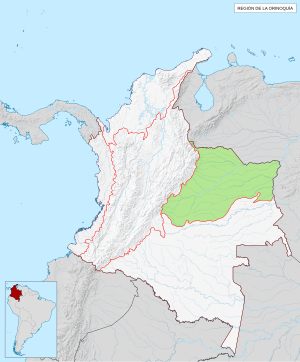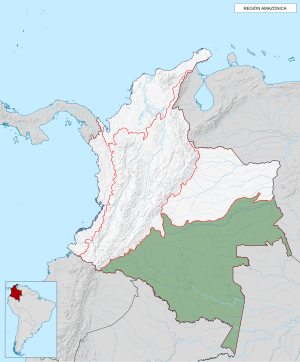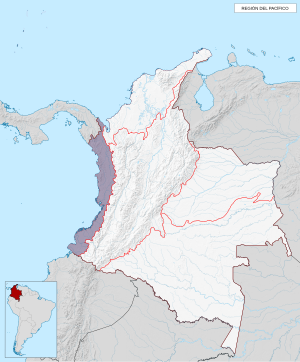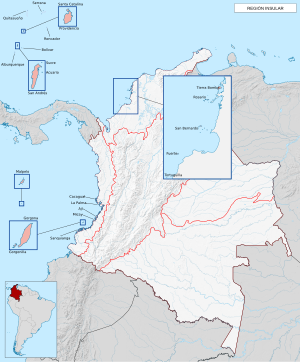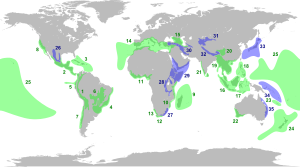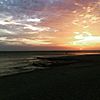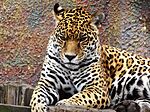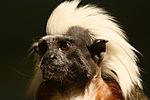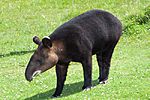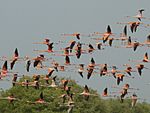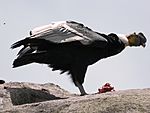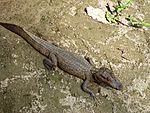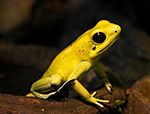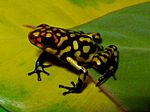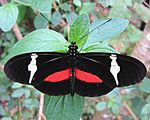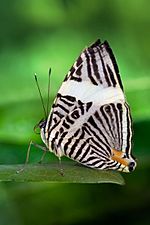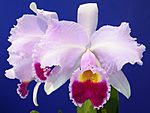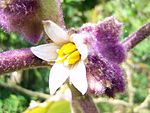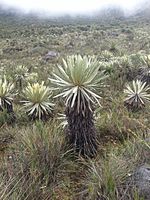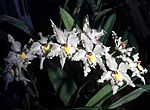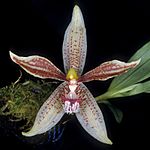Biodiversity of Colombia facts for kids
Colombia is an amazing country in South America, known for having the second-highest biodiversity in the world! This means it has a huge variety of plants, animals, and tiny living things. Imagine, as of 2021, about 63,000 different species have been found here. About 14% of these species are endemic, which means they are found only in Colombia and nowhere else on Earth!
Colombia is number one in the world for the number of different orchids, birds, and butterflies. It's also second for plants, amphibians (like frogs), and freshwater fish. Plus, it's third for palm trees and reptiles, and sixth for mammals.
The country has 59 special protected areas to keep its nature safe. Former Colombian president Juan Manuel Santos once said, "Biodiversity is to Colombia, what oil is for the Arabs," showing how important its natural wealth is.
However, Colombia's amazing biodiversity faces challenges. Things like losing natural homes for animals, cities growing, cutting down forests, and too much fishing can harm these precious species. Scientists at the Humboldt Institute have been collecting samples since 1998 to study and protect Colombia's incredible natural treasures.
Contents
Why is Colombia So Diverse?
Colombia is one of only seventeen "megadiverse" countries in the world. This means it has an incredibly high number of different species. The country has 311 types of ecosystems, from coasts to mountains. It also has more páramos (special high-altitude wetlands) than any other country, with over 60% of the world's páramos found here! The most diverse areas are the Andean mountains and the Amazon rainforest regions.
Amazing Animals and Plants in Numbers
Colombia is home to a stunning number of different life forms. Here's a quick look at some of the groups and where Colombia ranks globally for them:
| Class | Group | World Rank | Number of Species |
|---|---|---|---|
| Vertebrates (animals with backbones) | Mammals | 4 |
|
| Birds | 1 |
|
|
| Reptiles | 3 |
|
|
| Amphibians | 2 |
|
|
| Marine fish |
|
||
| Freshwater fish |
|
||
| Invertebrates (animals without backbones) | Lepidoptera (butterflies and moths) | 1 |
|
| Ants |
|
||
| Marine molluscs |
|
||
| Marine sponges |
|
||
| Corals |
|
||
| Marine decapods |
|
||
| Echinoderms |
|
||
| Land molluscs |
|
||
| Beetles |
|
||
| Arachnids (spiders, scorpions) |
|
||
| Bees |
|
||
| Diptera (flies) |
|
||
| Flora (plants) | Flowering plants |
|
|
| Flowerless plants |
|
||
| Orchids | 1 |
|
|
| Ferns and relatives |
|
||
| Palm trees | 3 |
|
|
| Mosses and relatives |
|
||
| Algae | Land algae |
|
|
| Marine algae |
|
||
| Fungi | Lichen |
|
|
| Macrofungi (large fungi) |
|
||
| Rusts (plant diseases) |
|
||
| Smuts (plant diseases) |
|
To celebrate this amazing biodiversity, the coins of the Colombian peso (Colombia's money) that came out in 2012 each show a different species!
Colombia's Natural Regions
Colombia is divided into six main natural regions, each with its own unique environment and species.
Caribbean Natural Region
This region is on Colombia's northern coast, next to the Caribbean Sea. It has beautiful beaches, wetlands, and dry forests.
- Size: About 132,288 square kilometers (51,077 sq mi).
- National Parks: Many parks protect its coasts and islands, like Tayrona and Corales del Rosario.
- Biodiversity:
- Aquatic birds: 165 species
- Amphibians: 39 species
- Reptiles: 129 species
- Plants: 3,151 species
- Fish: 109 species
Andean Natural Region
This region is made up of the Andes mountains, which run through Colombia. It has high peaks, valleys, and the unique páramo ecosystems.
- Size: About 282,540 square kilometers (109,090 sq mi).
- National Parks: Includes famous parks like Chingaza and Los Nevados.
- Biodiversity:
- Aquatic birds: 14 species
- Amphibians: 485 species
- Reptiles: 220 species
- Plants: 11,500 species
- Fish: 197 species
Orinoquía Natural Region
Also known as the Eastern Plains, this region is mostly flat grasslands and savannas, with many rivers that flow into the Orinoco River.
- Size: About 285,437 square kilometers (110,208 sq mi).
- National Parks: Parks like La Macarena protect its unique landscapes.
- Biodiversity:
- Aquatic birds: 92 species
- Amphibians: 57 species
- Reptiles: 119 species
- Plants: 2,692 species
- Fish: 619 species
Amazon Natural Region
This region is part of the vast Amazon rainforest, known for its dense forests and incredible variety of life.
- Size: About 483,911 square kilometers (186,839 sq mi).
- National Parks: Home to huge parks like Amacayacu and Chiribiquete.
- Biodiversity:
- Aquatic birds: 74 species
- Amphibians: 158 species
- Reptiles: 195 species
- Plants: 5,300 species
- Fish: 675 species
Pacific/Chocó Natural Region
Located on Colombia's western coast, this region is very wet and has dense rainforests, known for its unique plants and animals.
- Size: About 83,170 square kilometers (32,112 sq mi).
- National Parks: Includes parks like Los Katíos and Utría.
- Biodiversity:
- Aquatic birds: 142 species
- Amphibians: 154 species
- Reptiles: 177 species
- Plants: 4,525 species
- Fish: 164 species
Insular Natural Region
This region includes Colombia's islands in both the Caribbean Sea and the Pacific Ocean, like San Andrés and Providencia. These islands have unique marine life.
- Size: About 300 square kilometers (116 sq mi).
- National Parks: Features marine parks like Malpelo and Gorgona.
- Biodiversity:
- Fish: 170 species (Corales del Rosario y San Bernardo)
- Corals: 52 species (Corales del Rosario y San Bernardo)
- Sponges: 25 species (Corales del Rosario y San Bernardo)
- Birds: 74 species (Old Providence Lagoon)
Biodiversity Hotspots
Colombia is home to two special "biodiversity hotspots": the Tropical Andes and Tumbes–Chocó–Magdalena. These are places with a very high number of unique species that are also facing threats. Colombia is also part of the World Network of Biosphere Reserves, with five special areas recognized for their important ecosystems:
| Name | Since | Image | Notes |
|---|---|---|---|
| Cinturón Andino |
|
||
| El Tuparro |
|
||
| Sierra Nevada de Santa Marta |
|
||
| Ciénaga Grande de Santa Marta |
|
||
| Seaflower |
|
Featured Species
Colombia's rich biodiversity means it has many fascinating animals and plants. Here are just a few examples:
Selected Animals
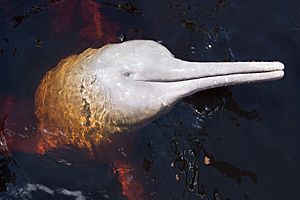
| Name | Species | Image |
|---|---|---|
| Jaguar | Panthera onca | |
| cotton-top tamarin | Saguinus oedipus | |
| mountain tapir | Tapirus pinchaque | |
| spectacled bear | Tremarctos ornatus | |
| American flamingo | Phoenicopterus ruber | |
| Andean condor | Vultur gryphus | |
| blue-billed curassow | Crax alberti | |
| Magdalena River turtle | Podocnemis lewyana | |
| spectacled caiman | Caiman crocodilus | |
| golden poison frog | Phyllobates terribilis | |
| harlequin poison frog | Oophaga histrionica | |
| green discus | Symphysodon tarzoo | |
| Clysonymus longwing | Heliconius clysonymus | |
| Dirce beauty | Colobura dirce | |
| Portuguese man o' war | Physalia physalis |
Selected Endemic Plants
These plants are found only in Colombia!
| Name | Species | Image |
|---|---|---|
| Colombian Orchid (National Flower) | Cattleya trianae | |
| Wax Palm (National Tree) | Ceroxylon quindiuense | |
| Lulo (National Fruit) | Solanum quitoense | |
| Borojó | Alibertia patinoi | |
| Frailejón | Espeletia killipii | |
| Odontoglossum crispum | ||
| Paphinia rugosa |
Selected Endemic Fungi
These fungi are found only in Colombia!
| Name | Species | Image |
|---|---|---|
| Cookeina tricholoma | ||
| Favolus brasiliensis |
Panoramas
See also
 In Spanish: Biodiversidad de Colombia para niños
In Spanish: Biodiversidad de Colombia para niños
- Conservation biology
- Environmental issues in Colombia



